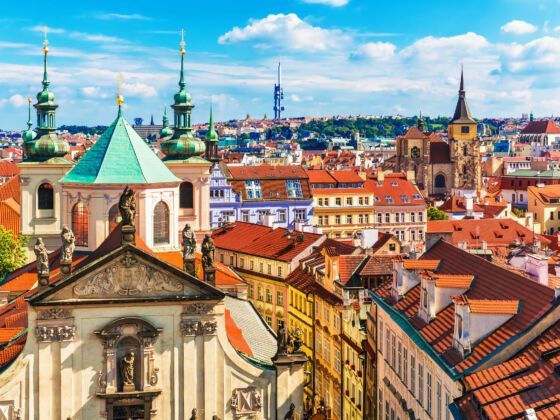

Despite the masses of tourists that have descended on the Czech capital in recent years — especially in summer — Prague remains one of Europe’s most attractive and atmospheric cities. It’s most famous for the winding cobbled streets of its two UNESCO-heritage listed historic centers (Old Town and Malá Strana), which are lined with immaculately preserved gothic, baroque, and renaissance buildings, and peppered with historic sights like the Powder Tower, the Astronomical Clock, Charles Bridge, and the Royal Palace. But the city has kept up with contemporary European trends too, and has chic bars and swanky nightclubs, convivial and upscale cafes and restaurants, plus some seriously hip fashion and design stores. Traces of the city’s communist past can also be discerned in trendy districts like Žižkov and Holešovice, which are home to an increasing number of vibrant community spaces, indie art galleries, and street food spots.
If you don’t like crowds, then try to avoid the city in summer. Spring or fall are particularly pleasant, with comfortable temperatures, and blooms or lovely autumnal shades in the city’s gardens. Winter can also be deeply atmospheric thanks to romantic layers of snow, enigmatic veils of fog, and cheery Christmas markets. If you do visit in summer, you can escape the tourist hordes quite easily by staying in neighborhoods like Holešovice and Vinohrady, which have a more local but vibrant ambience.
The currency throughout the Czech Republic is the koruna (CZK). The exchange rate is $20.78 per 1 USD. You can get your dollars exchanged at most banks and post offices, and there are also plenty of ATMs throughout the city centre. The main Czech banks include Komerční banka, Česká spořitelna, and Moneta; try to use these instead of private exchange booths (směnárna) as rates are usually better. In terms of tipping, it’s generally okay to round up your bill up to the nearest koruna for smaller purchases like coffee, cake, and snacks, but for lunches and dinners the standard is 10 to 15 percent — or more if you feel the service was notably good. Tips are usually given directly to the server when you pay, as opposed to leaving them on the table. Note that in tourist areas some restaurants automatically add the tip to the bill so check just in case. Taxis vary between those who will rip you off and those who are conscientious. Try to tip only the good cabs as you see fit or if they are helpful with bags; 10 percent is acceptable or just round up to the nearest 20 or 50 koruna.
Most locals in the city centre will speak some English, ranging from basic to excellent. However, attempts at the language are usually gratefully received, even if it’s just “děkuji” (“thank you”) or “prosím” (“please”), or a simple “dobrý den” (“good day”) or “dobrý večer” (“good evening.”)
Prague is easy and charming to get around on foot, but it also has a well-functioning and well- integrated metro, tram, and bus network. Trams are particularly convenient for crossing the river and moving between neighborhoods; buses are less useful, usually connecting the farther out neighborhoods to nearby metro stations or the center. Tickets can be bought at machines at metro stations and some tram stops (coins only), and also at newspaper kiosks. A normal ticket lasts 90 minutes but shorter and longer tickets are available, including day and week passes. Tickets are valid on all types of transportation, but transfers between them must be validated before use; validation machines are either at the top of escalators (metro) or inside buses and trams.
Serious crime is relatively low in Prague and most areas are safe to walk around, even after dark, although the area around the main train station can feel a little shady. Petty crime is fairly common, especially pick-pocketing, so be aware of your belongings in crowded tourist areas like Wenceslas Square, Charles Bridge, and Old Town Square. Call 112 for emergency services, 158 specifically for the police, and 155 for an ambulance or medical aid. The fire service is 150.